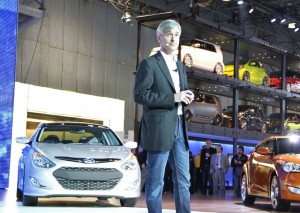It was a good year for Hyundai – perhaps too good.
The Korean carmaker, long known for providing cheap and cheerful econoboxes, scored a solid hit with its must upscale model ever, the premium-Luxury Equus. It landed its second win with a coveted North American Car of the Year trophy for the compact Hyundai Elantra sedan. And it saw sales surge to another record.
The numbers would have gone even higher, contends John Krafcik, CEO of Hyundai Motor America, if the maker had enough capacity. “Even in the worst days after the earthquake and tsunami hit Japan, our inventories have been shorter than either Toyota or Honda,” he said during a conversation with TheDetroitBureau.com.
The Korean carmaker is actively looking for ways to boost production at its Alabama assembly plant, as well as at a factory run by its sibling Kia providing some additional product for Hyundai dealers. But barring a sudden slowdown in sales, Krafcik believes Hyundai can’t come near to meeting potential U.S. demand in 2012.
“It’s a delightful constraint,” insisted the ever-upbeat executive, which will shift Hyundai’s priorities to “focus on customer satisfaction. We will have the chance to invest in our future.”
Hyundai sales have been on the fast track for several years. The maker thought it would do well if it could jump from a previous record 538,000 in 2010 to 595,000 last year. In fact, it hit 640,000, with overall demand up 20%, and a 29% jump on the retail side. The industry overall saw a 13% increase in 2011.
Currently, noted Krafcik, Hyundai dealers have “less than a month” inventory – the industry norm running around 60 to 70 days.
There are any number of factors that have contributed to that jump. Certainly, a broader line-up helps. The maker has continued expanding into as many niches as it can fill with products like the well-received Veloster, a quirky coupe/hatchback that features one door on the driver’s side, two on the passenger side. A turbo version will launch later this year.
Long known for marketing to the bottom end of new car buyers, Hyundai has moved upscale with products like the Equus and mid-lux Genesis, the sedan version of which was the first Hyundai to won North American Car of the Year honors, four years ago.
“That was huge for us. People underestimate what that did for us,” said Krafcik. Winning the trophy with Elantra would do even more – except for the fact “we don’t have any more cars to sell, so we’ll use (the award) for brand building.”
Few makers have focused more on brand image in recent years. Hyundai has aimed to address all the traditional concerns about the brand, starting with its early-on reputation for quality problems, to which it responded with a 10-year warranty program.
Recent marketing has emphasized fuel economy, Hyundai highlighting its four models getting more than 40 mpg on the highway. The maker has taken some criticism, notably from a group called Consumer Watchdog that has questioned the mileage claims for the Elantra.
Hyundai stands by its EPA-rated numbers – and the maker last week won the endorsement of TrueCar.com, a data tracking service that reported the Korean carmaker had the highest average fuel economy of any major maker in the U.S. market.
Significantly, Hyundai has been one of the more proactive supporters of efforts to increase federal mileage standards. With hearings this week underway on a proposed jump to 54.5 mpg by 2025, Krafcik declared, “Of course, we’re positive on it,” noting his personal philosophy that “you need to set targets you’re not sure you can meet or you’re probably not stretching far enough.”
There are still plenty of things that need work, Krafcik cautioned, among them the maker’s “retail experience.”
Hyundai set out to redefine the sales and service process when it launched the Equus. Among other things, customers can handle the entire sales transaction without ever setting foot in a showroom. Dealers will drop off the car at home or office – and handle pickups when service is needed.
Meanwhile, though Hyundai has also shown strong gains in quality scores, Krafcik said he is far from satisfied, contending, “We’re not perfect yet.”
But production capacity is likely to be one of his toughest challenges. The Alabama plant produced 338,000 vehicles last year, while the Kia plant in Georgia rolled out 82,000 for its Hyundai partner – in all, about two out of every three Hyundai products sold in the States built on an American assembly line.
Could another plant be in the offing? “No,” said Krafcik before pausing and correcting that to, “Not yet.” The maker was burned during its early years in North America when sales collapsed and it had to shutter an earlier plant in Quebec. There’s no way Hyundai wants to go through that again. For now, it will struggle with the process of fixing bottlenecks to boost capacity at its existing plants in the U.S. and Korea.
But longer-term? Well, if the demand is there, don’t be surprised to see Hyundai take the steps it needs to keep the momentum building.

